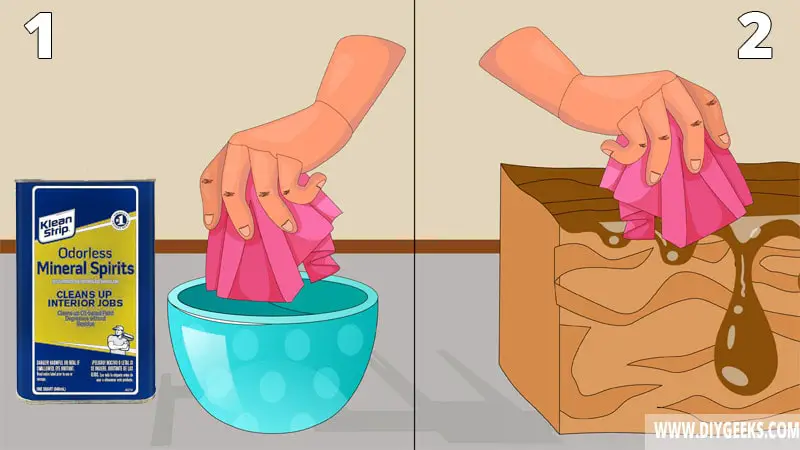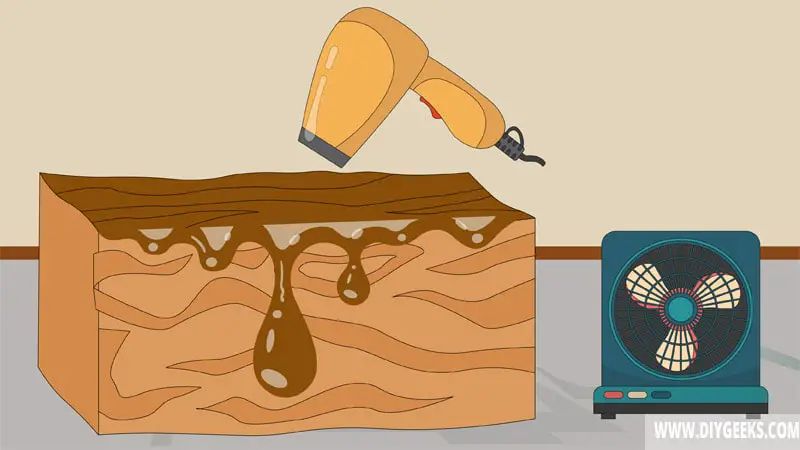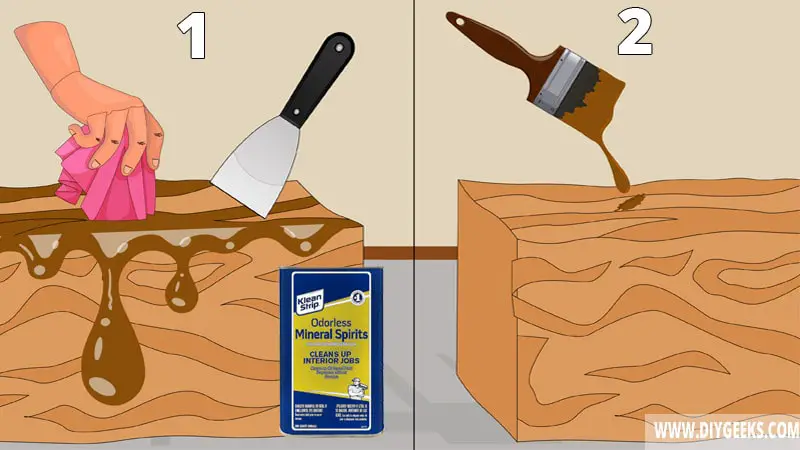Gel stain is a type of wood stain that has a thick, gel-like texture that sticks to vertical and horizontal surfaces without penetrating them deeply.
Gel stain isn’t drying because you didn’t remove the excess after applying it, high humidity (or moisture), or too many coats.
To fix a Gel stain that isn’t drying, wipe off the excess, use a hairdryer, or remove and re-apply the Gel stain.
Why Isn’t Gel Stain Drying?
Gel stain isn’t drying because you didn’t remove the excess after application, because of high humidity (or moisture), bad weather or low temperature, improper surface preparation, or too many coats.
Before you conclude that the finish isn’t drying, wait 24-48 hours first. If the finish doesn’t dry within 48 hours, there’s something wrong and it will remain tacky and won’t dry itself.
1. You Didn’t Remove the Excess
If you don’t wipe the excess 30 minutes after applying, there will be too much gel stain on the surface that can’t penetrate the surface, leading to increased dry time and a wet coating.
2. High Humidity or Moisture
All types of finishes are affected by moisture — the more it is exposed to, the longer it will take to dry. Moisture can come from water, spills, leaks, cracked pipes, or rainfall. If the finish is exposed to these elements, the water (or moisture) will keep it wet and prevent it from drying.
The soaked water will add the amount of solvent to the coating. So, this becomes a never-ending cycle where some solvent evaporates, but constant exposure to water adds more solvent. And, until the solvent is evaporated, the coating won’t dry or become rigid.
3. Bad Weather and Low Temperature
If the weather is too cold, the finish won’t dry because the temperature and humidity levels will be too high. If the humidity levels are too high, there’s water in the atmosphere that reduces the evaporation rate of the solvent. This increases the drying time.
However, if the weather is warm, the coating will dry faster because the evaporation process will be completed faster.
4. Improper Surface Preparation
Before applying Gel stain, you must sand and clean the surface properly. If you don’t, the stain won’t dry because the dirt (or dust) underneath will prevent it from drying.
5. Too Many Coats
If you apply too many coats, there will be too much Gel stain on the surface, and wood can’t absorb all of it. So, the extra or excess stain will remain wet since it can’t stick or penetrate the surface. Also, the excess stain will prevent the underneath coatings from drying because too many coats will reduce or stop the evaporation process.
Does Gel Stain Dry itself?
Gel stain does dry itself if the sticky finish is caused because you applied too many coats or recoated too soon. Once the temperature and air circulation rise, the evaporation process accelerates and the finish dries.
Gel stain won’t dry itself if the finish has been tacky for more than 48 hours. Gel stain dry time is 12-24 hours, but it can take up to 48 hours to dry under moist or humid conditions. If the 48-hour mark passes, there’s something wrong with the coating or the surface, so the finish doesn’t dry itself.
The tacky finish won’t dry itself if it’s caused by a wet surface, improper preparation, or exposure to constant water. That’s because there’s an external factor preventing the finish from drying. Unless you fix (or remove) the external factor, the finish will remain wet.
In this case, it’s recommended to remove the whole finish, fix the problem, and re-apply it.
How To Fix Gel Stain That Isn’t Drying?
To fix a Gel stain that isn’t drying, do the following things.
- Wipe Off the Excess.
- Use a Hairdryer.
- Remove and Re-apply Gel Stain.
1. Wipe Off the Excess

Since the Gel stain has a thick viscosity, remove the excess stain 30 minutes after applying it. If you don’t, the excess stain will prevent the stain underneath from drying, causing the finish to turn sticky.
The tools you need for this method are listed below.
- Clean rags
- Mineral spirits
- A plastic bag or nylon
- Water-based polyurethane
- A clean bowl
A guide for this method is listed below.
- Pour mineral spirits into a clean bowl.
- Damp a rag with mineral spirits.
- Use the dampened rag to wipe the gel stain coating repeatedly.
- Wait around 10 minutes.
- Wipe excess wood stain from the surface.
- If the finish becomes too light, apply one more coat.
- Leave the finish to dry.
Related Read: Sticky Wood Stain? Here’s The Fix
2. Use a Hairdryer

If the gel stain finish isn’t drying because the room temperature is too low, the humidity levels are too high, or the solvent evaporation rate is too low, use a hairdryer and dehumidifier.
The hairdryer will increase the temperature around the coating, increasing the evaporation rate and speeding up the drying time. The dehumidifier will lower the humidity levels and also increase the evaporation rate.
The tools you need for this project are listed below.
- A dehumidifier
- A hairdryer
- Rags
- Wood caulk
- Gel stain
- A paint tent (optional)
A guide for this project is listed below.
- Turn on the dehumidifier and place it near the coating. Don’t turn it off unless the finish dries.
- Turn on the hairdryer, use medium temperature, and direct it over the gel stain coating.
- Move the hairdryer around the coating for 5 minutes.
- Allow the coating to dry naturally.
Don’t use a hairdryer to fully dry a coating because the paint particles will dry too fast and won’t have enough time to harden naturally. This causes a weak finish.
3. Remove and Re-apply Gel Stain

If the gel stain finish isn’t drying because of an external factor such as a wet surface, improper preparation, or a water leak, remove the finish and fix the problem before re-applying it.
After removing the gel stain finish, ensure to prep the surface by sanding and cleaning it before re-applying the wood stain. If the surface is wet, apply stain-blocking primer.
The tools you need for this project are listed below.
- Sandpaper
- Rags
- Mineral spirits
- Acetone
- A paint scraper
- A duster
- Gel stain
A guide for this project is listed below.
- Damp a rag with mineral spirits.
- Use the dampened rag to wipe the gel stain finish repeatedly.
- Wait around 20 minutes.
- Use a paint scraper to scrape the gel stain off the wood.
- Re-apply mineral spirits for leftover Gel stain.
- Inspect the surface, find the problem, and fix it.
- Clean and sand the surface.
- Apply stain-blocking primer.
- Re-apply the Gel stain and leave it to dry.
Tip: If you find gouges or holes in the wood after removing the gel stain, seal them with a wood conditioner before re-applying it.
Other tips you can use:
- Open the windows and doors to increase the airflow — this also increases the evaporation rate.
- Leave enough dry time before re-coating.
- Thin Gel stain before applying it.


